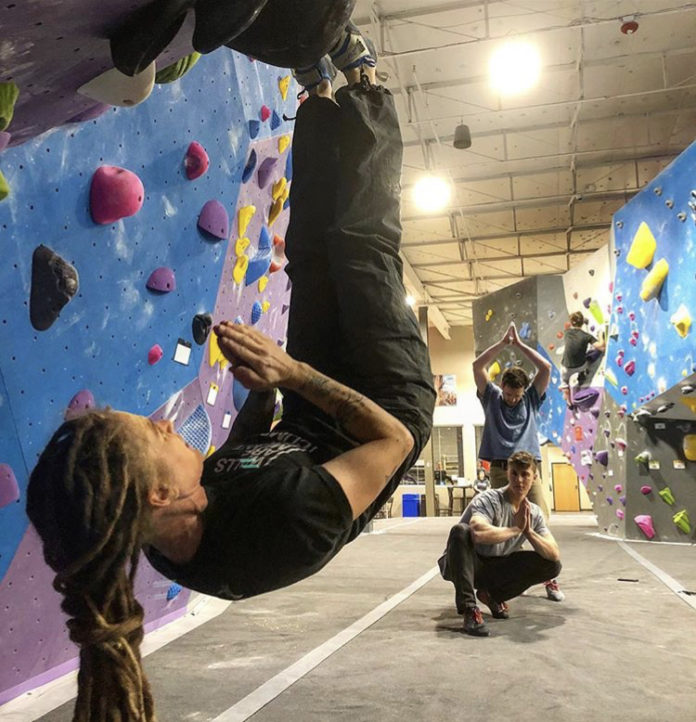
Behind the Wrench…is an ongoing series that interviews the “rock stars” of the climbing industry: the routesetters at the gyms. This time CBJ hits the road and heads to the East Coast to discuss slabs, safety zones, setter wellness and how to create the best darn bat hang your local gym has ever seen.
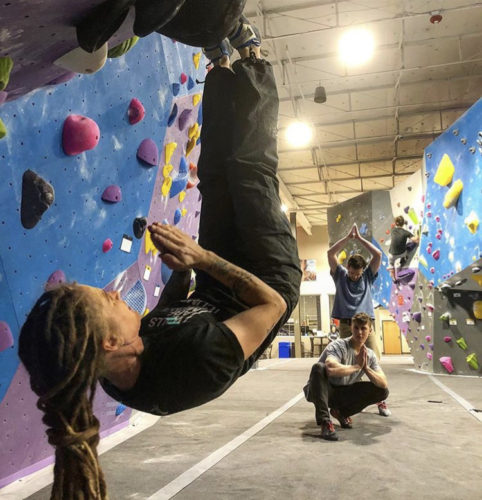
Name: Alison Krayer
Home Gym: Earth Treks Hampden
Location: Baltimore, Maryland
CBJ: Are you from the Baltimore area originally, and how did you get into routesetting at Earth Treks as a career?
KRAYER: I am not from the Baltimore area originally. I moved to Baltimore as a step forward in my career when Earth Treks announced they were building their first bouldering-only gym and were looking for routesetters. I flew down from Maine, where I was living and setting at the time, and had a two-day, almost- 24-hour interview where I set both boulders and rope routes. Back in 2013, I started setting when I worked as the Assistant Director for Earth Treks in Rockville, Maryland. With my background in Art and Design and my previous job as a bicycle builder/mechanic, routesetting seemed like the perfect blend of all my skill sets and interests.
The path to setting as a career back then was not a clear one. I did a lot of routesetting for free and traveled around to wherever I could set. I purchased all my own tools and signed myself up for the USAC Level 1 routesetting clinic, which was the only real setting instruction at the time. Eventually, I landed at EVO Rock and Fitness in Portland, Maine. There I had the freedom to really explore routesetting as a career and the opportunity to set for a variety of comps, both youth and citizens comps.
CBJ: What are some things that make routesetting at Earth Treks Hampden unique?
KRAYER: There is a lot of slab terrain, which proves to be a challenge for routesetting at times, and there is a member base of fairly new climbers. I’m also a coach and I focus a lot on instruction while I am setting. I will focus on a technique for the climber to work on and learn at a specific grade to aid in their progress as not only a strong climber, but a smart one.
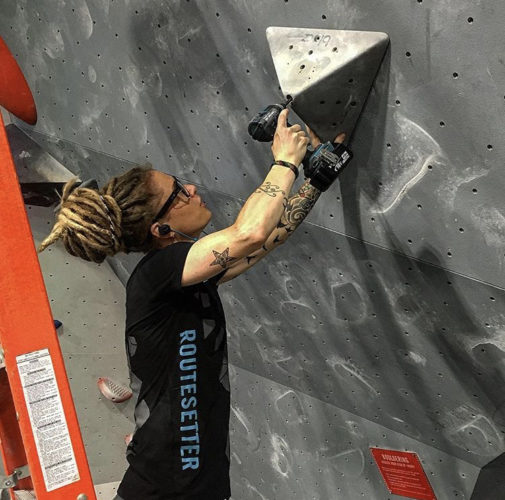
CBJ: How has setting—either the actual craft, or the idea of being a routesetter as a job—changed since you first started setting?
KRAYER: It has changed in so many ways, from the variety and complexity of hold selection to actual styles of setting. Climbing gyms used to be places where climbers trained for climbing outside—and the routesetting reflected that. With the current rate of growth within gym climbing alone and with climbing now being an Olympic sport, the possibilities in styles of routesetting are endless. That growth has also brought with it a real need for experienced, talented route setters and it has been great to see all the new career opportunities for us.
When I first started setting, I didn’t know a single other woman who routeset. Now, I know and have personally set with close to 30 different women setters. This is a huge change, and personally the most exciting one for me. I am so grateful that today there is a much clearer path for women who want to get into routesetting as a career. Women have proven to be a valuable asset to any setting team. We still have a long way to go, but the change I have seen and am so grateful to be a part of is a step in the right direction.
CBJ: We’ve had conversations at CBJ about how routesetters are basically the keys to the industry (the “rockstars”). But I know a lot of gym patrons just climb and don’t think much about the hard work that goes on “behind the scenes” to make the routes. Is there anything the whole industry or even just an individual gym could do to make sure routesetters get the full credit and recognition they deserve?
KRAYER: At some gyms I have seen a “meet your routesetter” wall where there are photographs of the routesetters and a short, usually comical, bio. I think this is a great way to provide setter recognition. When I was at EVO, we made weekly “boulder of the week” videos featuring individual routesetters, which I really enjoyed making and miss. They provided routesetter recognition as well as a source of member stoke for the new boulders we set.
More important than recognition, I think, would be overall care from gyms and the industry at large for routesetter health and wellness. Being a commercial routesetter is an extremely physically demanding job and more affordable and accessible health care like massage therapy and physical therapy would be a great way to show routesetter appreciation. For me personally, my craft suffers when my body is physically beat up and not cooperating.
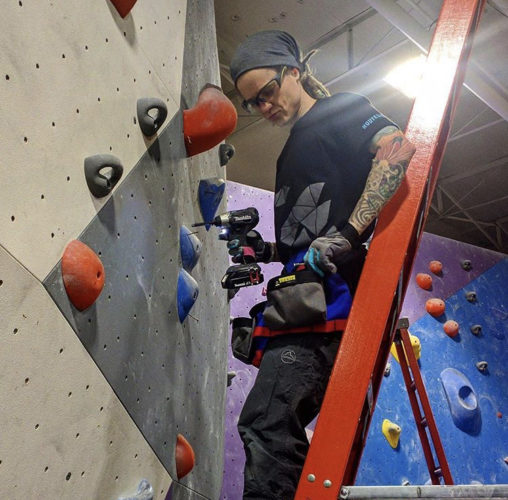
CBJ: What’s your typical day like as a setter?
KRAYER: My typical day starts with lots of coffee followed by setting up the safety zone for the area we are setting that day. Then we strip all current boulders, wash holds and decide what grades we need set based on the gym’s bell curve. Depending on my level of inspiration I might set a really hard or technically complicated boulder first, or I might knock out one of the easier, trainer-style boulders to warm up.
After setting all the boulders, we forerun and make changes, adjustments, and improvements. This process takes hours and has the potential to be the most collaborative part of the setting day, which I enjoy.
CBJ: Speaking of parts of the day that you enjoy, what are the best parts of being a routesetter, and what are the biggest challenges?
KRAYER: For me, the best part of being a routesetter is watching climbers grow and have an amazing time on climbs I created. Same thing goes for watching climbers compete on comp climbs I set. I also really enjoy when people talk to me about my climbs, whether they are complimenting, criticizing, or just have specific beta questions.
The biggest challenges involve constantly coming up with new and inspired routes, as well as just general fatigue—brain fatigue to be specific. During a day of setting, and more often during a hard week of comp setting, there are so many decisions to make and things to consider. I have fallen/slid down the ladder, smashed my hand between a hold and the wall with my drill, and straight-up split my head open from walking into a ladder at the end of long, exhausting comp weeks. I always end up laughing it off because it is ultimately quite comical despite the pain.
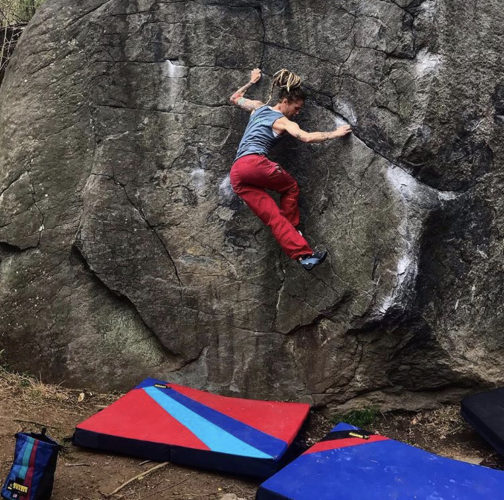
CBJ: And what influences your setting?
KRAYER: I am inspired in every aspect of my life by the outdoors. This is very true for my inspiration for routesetting. I am definitely also inspired by teaching technique or a specific movement or flow, but I am most inspired by climbing outside or watching other people and animals—I am in awe of the climbing ability of squirrels—climb outside.
CBJ: What’s your favorite move to set—and do you have any tips or advice on how best to set the move?
KRAYER: My favorite move to set is definitely a double toe hook or bat hang. The best tip I can give is to find some good steep terrain and decent holds, and to physically try the moves until you get the result you want. An important thing to check when setting a forced bat hang is that the climber can’t cheat past your intended beta by campusing the whole thing. This will be your biggest challenge.
CBJ: If you had to narrow routesetting down to three key points, what would those be?
KRAYER: First, routesetting should ultimately be a fun job! We are not performing brain surgery, so don’t take yourself too seriously. Enjoy your work and even better, the experience of seeing others enjoy it.
Second, find ways to stay inspired. Climb outside, travel to other gyms and get on other routesetters’ climbs, or whatever reminds you of why you love setting and what drew you to it in the first place.
Third, push yourself outside of your climbing and routesetting comfort zones. Every opportunity is a chance to learn and grow, and something that feels unfamiliar or uncomfortable just means you’re having a learning experience. The more you challenge yourself, the more you’ll have to bring to your routes and to the communities and people who climb them.
Got a cool story? Tell us!
Do you know a routesetter in the climbing industry who would be good to profile in a Behind the Wrench segment? (Or, are you a routesetter and have a personal background that you think others would enjoy learning about?) If so, please contact us and tell us about it!

John Burgman is the author of High Drama, a book that chronicles the history of American competition climbing. He is a Fulbright journalism grant recipient and a former magazine editor. He holds a master’s degree from New York University and bachelor’s degree from Miami University. In addition to writing, he coaches a youth bouldering team. Follow him on Twitter @John_Burgman and Instagram @jbclimbs. Read our interview Meet John Burgman, U.S. Comp Climbing’s Top Journalist.








